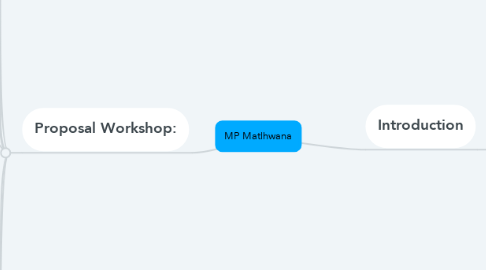
1. Introduction
1.1. Level: MSc - By Dissertation
1.2. WMI: Digital Mining
1.2.1. Theme: Underground health, safety and security technologies
1.3. Part of larger MHSC-funded research project - Development of an Underground UAV for Mining
1.4. Ms Matlhwana is the Ventilation Engineer on the team
1.5. Approach: Idea - Concept - Proposal - Technology development
1.5.1. Through a workshop approach: Process: Idea - Concept - Proposal - Funding, etc.
1.5.2. Ideation
1.5.2.1. Outcome
1.5.2.1.1. Mining UAV prototype development
1.5.3. Concept development
1.5.3.1. Risks associated with Ventilation Engineering to be identified
1.5.3.2. Data to be collected, communicated, processed and alarms communicated
1.5.4. Proposal
1.5.4.1. This workshop
1.5.5. Technology development
1.5.5.1. Prototype development - PhD candidate SoCS
2. Proposal Workshop:
2.1. 1. Introduction
2.1.1. Provisional Title
2.1.1.1. Developing an underground UAV platform cluster for Mine EMS: Towards a rapid integrated approach to manage and control environmental risks in underground mining under different scenarios
2.1.2. Aim and objectives of the study
2.1.2.1. Problem statement
2.1.2.1.1. Different requirements
2.1.2.1.2. Harmful components and contaminants in air
2.1.2.1.3. Visibility
2.1.2.1.4. Heat
2.1.2.1.5. Radiation
2.1.2.1.6. Noise
2.1.2.2. Research question(s)
2.1.2.3. Purpose of the study
2.1.2.3.1. Framework for ventilation monitoring and control from a control room environment using an Underground UAV
2.1.2.3.2. Why?
2.1.2.4. Background and context
2.1.2.4.1. This topic is more than health and safety problem
2.1.2.4.2. Better to lose a machine than a person
2.1.2.4.3. Standards and Regulations apply
2.1.2.5. Understanding the issues
2.1.2.5.1. Technical issues
2.1.2.5.2. Human factor issues - worker acceptance
2.1.2.5.3. Skills and correct use
2.1.2.5.4. Understanding the data and making it useful
2.1.2.6. Benefit to industry/profession/community/etc.
2.1.2.6.1. Better understanding of the problem
2.1.2.6.2. Safety and health
2.1.2.6.3. Environmental
2.1.2.6.4. Business case
2.1.2.7. Case study
2.1.2.7.1. DigiMine smart systems
2.1.2.7.2. Measurements, upgrade and software modeling - Vuma Live!
2.1.2.8. Factors (sometimes assumptions) that could impact on the outcome
2.1.2.8.1. Resources required etc.
2.1.2.8.2. Data
2.1.2.8.3. WSN coverage
2.1.2.8.4. Who is funding the work
2.2. 2. Literature review
2.2.1. Part 1
2.2.1.1. Case studies - Disasters
2.2.1.1.1. Role of technology for disaster management in mining
2.2.1.1.2. Mine rescue services
2.2.1.2. Risk management
2.2.1.2.1. Ventilation design - How to use (surface) sensor data to model underground environment
2.2.1.3. Guidelines and Regulations
2.2.1.3.1. MHS Act
2.2.1.3.2. Industry protocols
2.2.1.3.3. Zero harm
2.2.1.4. EMS
2.2.2. Part 2
2.2.2.1. UAV - Stuart's MSc
2.2.2.2. MHSC Contracts documents - DigiMine File
2.2.2.3. Digital systems for EMS
2.2.2.3.1. DigiMine
2.2.2.3.2. Dr Feroze - Ansys modeling CFD etc
2.2.2.3.3. Sensors (Miniturization is an issue)
2.2.2.4. Systems Engineering - Fan's MSc
2.3. Research objectives
2.4. Envisaged contribution to new knowledge (PhD only)
2.5. Ethical issues/Clearance
2.6. Deliverables and project schedule
2.6.1. Developing an underground UAV platform cluster for Mine EMS: Towards a rapid integrated approach to manage and control environmental risks in underground mining under different scenarios
2.6.2. Tentative Outline
2.6.2.1. Chapter 1: Introduction
2.6.2.2. Chapter 2: Literature review Part 1
2.6.2.3. Chapter 3: Literature review Part 2
2.6.2.4. Chapter 4: EMS requirements for UAV and sensor selection
2.6.2.5. Chapter 5: Data architecture design
2.6.2.5.1. Collection
2.6.2.5.2. Transmission
2.6.2.6. Chapter 6: System integration
2.6.2.6.1. Data
2.6.2.6.2. Other systems
2.6.2.6.3. Software modeling
2.6.2.6.4. Visualization
2.6.2.7. Chapter 7: Approach to management and control of environmental risks using UAV data
2.6.2.7.1. Data
2.6.2.7.2. Processing
2.6.2.7.3. Analysis
2.6.2.7.4. Rule development
2.6.2.7.5. Decision/Alarm
2.6.2.7.6. Decision-making
2.6.2.8. Chapter 8: Implementation plan
2.6.2.8.1. Systems-thinking
2.6.2.8.2. Skills
2.6.2.8.3. Champion
2.6.2.8.4. Scenarios
2.6.2.8.5. Business case
2.6.2.9. Chapter 9: Conclusion and Recommendation
2.6.2.9.1. Back-up systems
2.6.2.9.2. Disaster management
2.6.2.10. Approach
2.6.2.10.1. Scenario
2.6.3. Tentative Schedule
2.6.3.1. Submission for assessment end of June 2019
2.7. Project budget
2.7.1. Funded by MHSC

